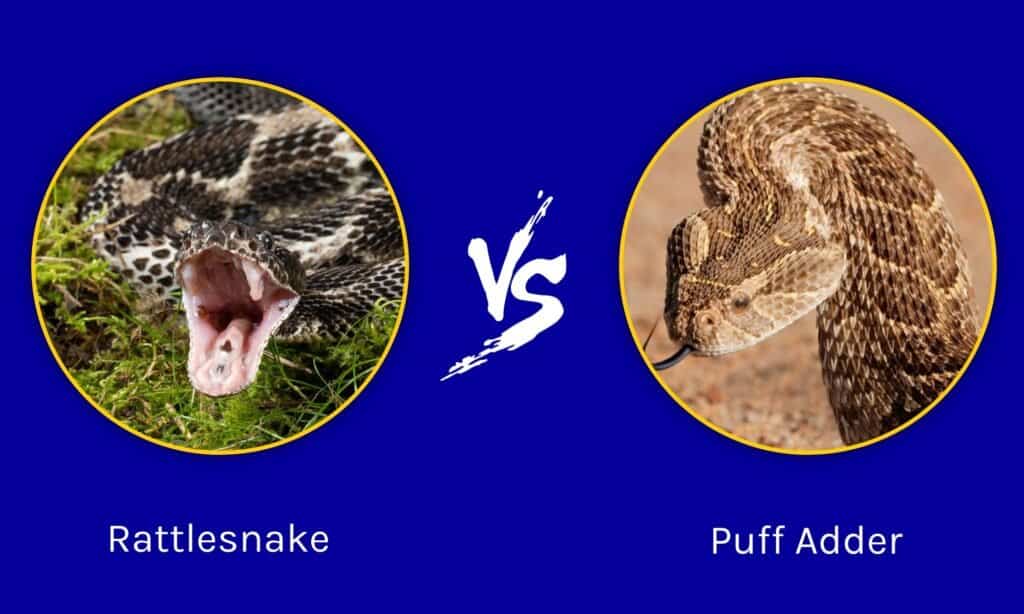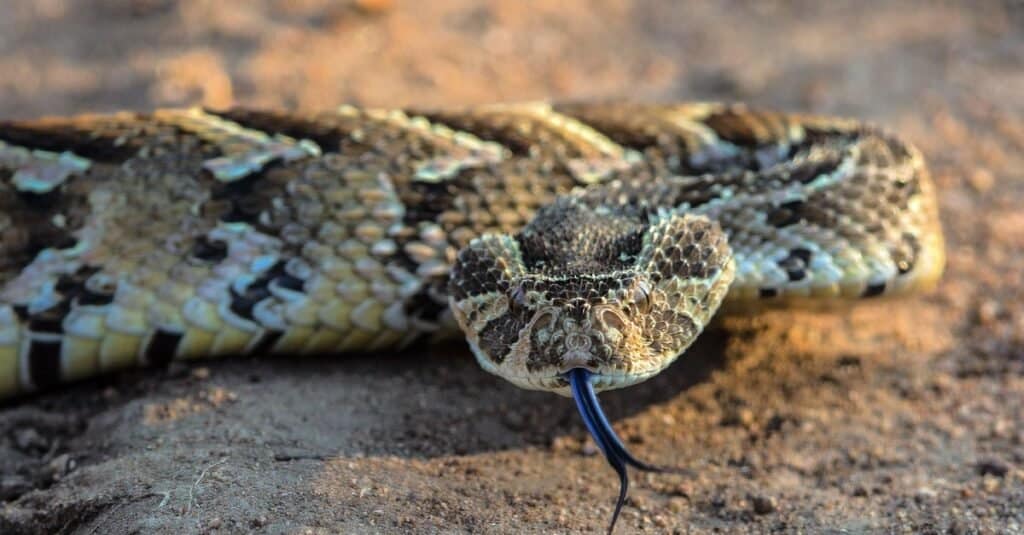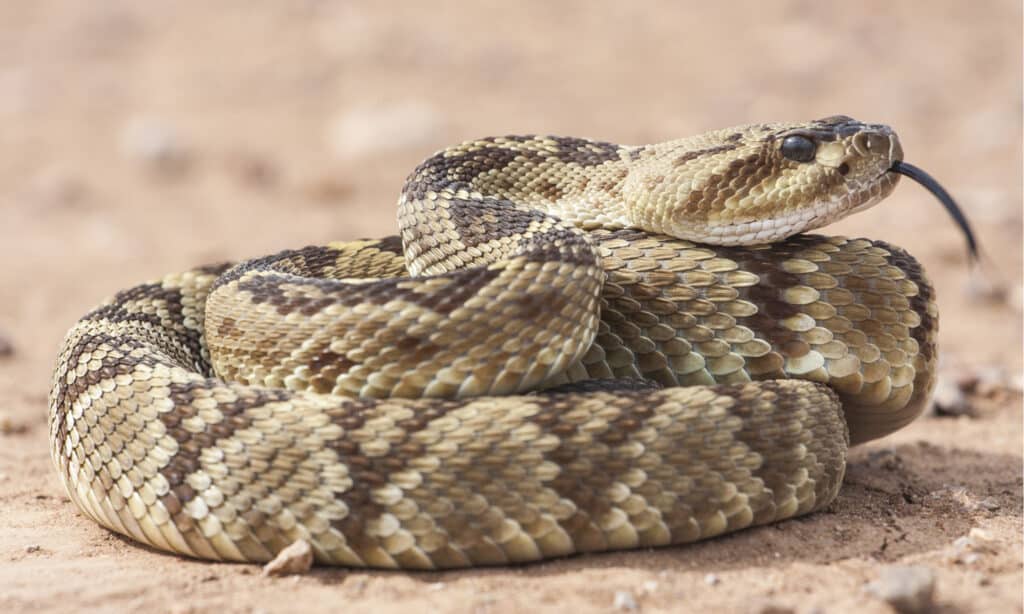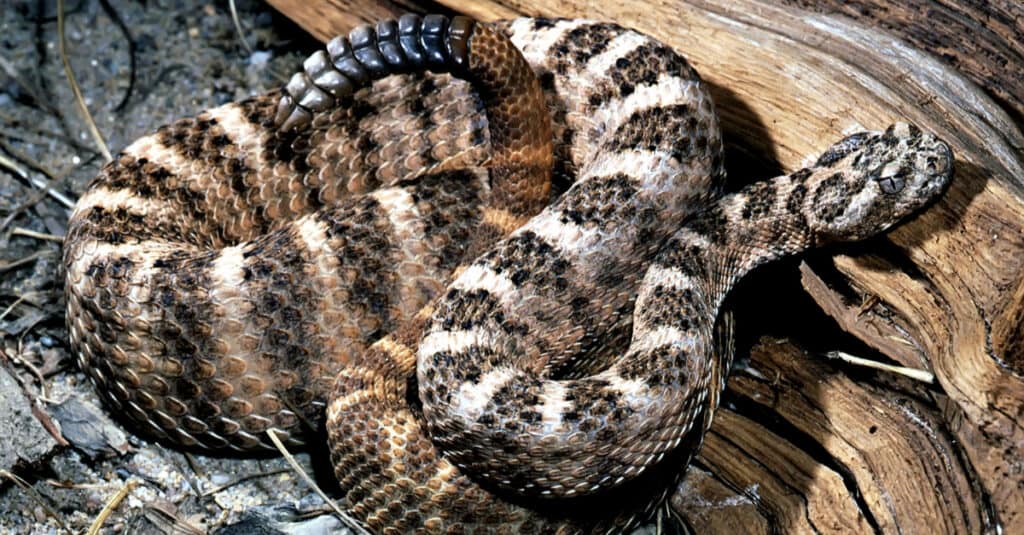Both venomous vipers, the rattlesnake, and the puff adder, have unique features and geographical ranges. The rattlesnake is named for the distinctive-sounding rattle at the end of its tail, used to warn of a potential strike. Similarly, the puff adder is named for defensive behavior. If threatened, it will puff up its body to appear much larger than it is. Both can inject powerful venom into their prey with fierce fangs, but one tends to be a riskier bite for humans. Let’s take a detailed look at rattlesnake vs puff adder, and decide what factors set these fanged serpents apart.
Comparison of a Rattlesnake and a Puff Adder

| Rattlesnake | Puff Adder | |
|---|---|---|
| Scientific Classification | Family: Viperidae; Genus: Crotalus, Sistrurus; 30+ species | Family: Viperidae; Genus: Bitis; Species: B. arientans |
| Range & Habitat | The Americas, southern Canada to Argentina; grassy areas, rocky hills, swamplands, meadows, and brushy areas | Throughout Africa, aside from Sahara and rainforest regions; savannas, open forests, and rocky grasslands |
| Size | average 1.5-6.5 ft, up to 8 ft, up to 10 lbs | average 3 ft long, up to 6 ft, up to 13 lbs |
| Appearance | Dark diamond patterns or other geometric shapes on a lighter colored body | Tan, brown, gold, and sometimes gray, with irregular wavy or chevron patterns of dark and light along the side of the body |
| Hunting | Ambush predator, fangs deliver venom, use heat-sensing pit organs | Ambush predator, fangs deliver venom, se lingual luring & caudal luring mimicry strategies |
| Venom & Bite Risk | Dangerous; Bites are medical emergencies but very rarely fatal if treated | Very dangerous; Responsible for more snakebite fatalities than any other African snake |
Key Differences between a Rattlesnake and a Puff Adder

The puff adder can be as long as five feet.
©iStock.com/S_Lew
The key differences between Rattlesnakes and Puff Adders are in terms of classification, size, range, and habitat.
Let’s explore these differences below.
Rattlesnake Vs Puff Adder: Scientific Classification
Rattlesnakes are venomous, fanged pit vipers of the family Viperidae. They derive their family name Viperidae from the latin vivus, “alive” and parere, “to bear.” This refers to their method of bearing live young. As pit vipers, they belong to the subfamily Crotalinae. The members of this subfamily are distinguished by their heat-sensing pit organs. There are over 30 rattlesnake species, and most fall into the genus of Crotalus. This genus name is derived from the word for “castanet.” There are a couple in the genus Sistrurus, meaning “tail rattler.” This name shares its root with the sistrum, a type of rattle that is an ancient Egyptian musical instrument.
The puff adder is also a venomous viper of the Viperidae family. It belongs with rattlesnakes in the subfamily Crotalinae. It is of the genus Bitis with the full species name of Bitis arientans. The latter part of this name is derived from the Latin word arieto, meaning “to strike violently.” The African puff adder and the Somali puff adder are the two recognized subspecies.
Rattlesnake Vs Puff Adder: Range & Habitat

Rattlesnake species live throughout the Americas.
©Viktor Loki/Shutterstock.com
Rattlesnakes are native to the Americas, from southern Canada to Argentina. The highest concentration of rattlesnakes live in the southwestern United States and northern parts of Mexico. Many rattlesnakes live in the dry desert climate of the southwest United States, but many thrive elsewhere. These snakes do well in grassy areas, rocky hills, swamplands, meadows, and brushy areas.
Puff adders are likely the most common and widespread snake species in Africa. They live throughout most of sub-Saharan Africa, parts of Arabia, and Morocco. They exist in the semi-arid environments of savannas, open forests, and especially rocky grasslands. They’re generally not found in the rainforest habitats of central Africa, but they do like to live with a source of water and good coverage nearby.
Rattlesnake Vs Puff Adder: Appearance

The puff adder has a distinct triangle-shaped head and a wavy or chevron-patterned body.
©iStock.com/EcoPic
Rattlesnakes vary significantly in size by species but are generally 1.5 to 6.5 feet in length. Some, like the eastern diamondback, can grow up to 8 feet in length and weigh up to 10 pounds. They have thick bodies and exhibit sexual dimorphism, with males typically growing slightly larger than females. Their coloration varies, but they typically have dark diamond patterns or other geometric shapes on a lighter-colored body. Their distinctive tail rattles are made of hollow keratin chambers that knock together to produce sound. These snakes have triangular heads and hinged fangs. Rattlesnakes have pit organs beside their nose and eyes, which detect the heat signatures of animals nearby like an infrared camera.
The puff adder is a thick, medium-sized snake that averages 3 feet long. Large specimens over 6 feet long and 13 pounds have been reported. It has a distinctive, triangle-shaped head. Coloring varies by species. The puff adder often exhibits body colors of tan, brown, gold, and sometimes gray, with irregular wavy or chevron patterns of dark and light along the side of the body. Their coloring helps them to camouflage, blending into their surroundings. Females generally show a slightly shorter tail than males.
Rattlesnake Vs Puff Adder: Hunting & Diet

The rattlesnake has pit organs and warns of a strike with its distinctive tail rattle.
©Vladislav T. Jirousek/Shutterstock.com
While they are both ambush predators who lie in wait for unsuspecting prey to pass by, the rattlesnake has pit organs, and the puff adder doesn’t. These pit organs act like infrared cameras to detect the body heat of animals nearby. When prey appears, rattlesnakes strike out quickly and sink their fangs to deliver venom. The venom immobilizes their prey, which includes rodents, birds, rabbits, and small creatures like frogs and lizards. They typically don’t need more than one meal every few weeks in adulthood.
The puff adder hunts in a similar ambush fashion, patiently waiting days or even weeks for prey to pass by. They eat a diet of primarily rodents, birds, frogs, other reptiles, and even small deer. Interestingly a study in Behavioral Ecology and Sociobiology found that they use two distinctive mimicry signals to lure prey. This is unique, as most species that exhibit mimicry use only one type of signal. They extended their tongues in an act called lingual luring and waved their tails in a deceitful maneuver called caudal luring. This mimicking of invertebrate actions works to lure their prey into striking distance.
Rattlesnake Vs Puff Adder: Venom & Danger
Rattlesnakes live in many areas where humans live and work, so the risk of exposure is fairly high. They produce a warning rattle before a potential strike. Attention to this distinctive warning rattle sound can help prevent a strike. The long fangs of the timber rattlesnake deliver venom that’s potent enough to kill a human. A defining characteristic of the timber rattlesnake is crotoxin, or “canebrake toxin.” This is a potent neurotoxin that can lead to paralysis. Rattlesnake bites should be treated as medical emergencies as the hemotoxin in their venom kills red blood cells and leads to tissue damage. Antivenom is widely available, and human deaths are rare as long as treatment is delivered.
Puff adders are extremely dangerous snakes, one of the most dangerous snakes in Africa. They have a wide geographic range and a tendency to bask on footpaths. Their tendency for camouflage makes it so that people often stumble upon them. These snakes would rather stand their ground than flee when threatened. Their name comes from their tendency to puff up their bodies to appear much larger than they are. They’ll also give a warning hiss before striking. Their venom is cytotoxic, meaning that it is toxic to cells. They have one of the most poisonous venoms of all viper species. Although highly dangerous, the prognosis is usually good for those bitten who receive antivenom in time. Without it, the fatality rate can exceed 15 percent.
The photo featured at the top of this post is © iStock.com/S_Lew
Discover the "Monster" Snake 5X Bigger than an Anaconda
Every day A-Z Animals sends out some of the most incredible facts in the world from our free newsletter. Want to discover the 10 most beautiful snakes in the world, a "snake island" where you're never more than 3 feet from danger, or a "monster" snake 5X larger than an anaconda? Then sign up right now and you'll start receiving our daily newsletter absolutely free.
Thank you for reading! Have some feedback for us? Contact the AZ Animals editorial team.






